When there is not much to look at your house border, consider landscaping along a fence ideas. They could be more than just a solution. Such a landscape provides privacy as well as safety for you and your other house dwellers.
The inside lookers will have an enjoyable view, while for the passersby, it adds curb appeal. The other reasons as to why you should grow plants along the fence are they soften up, brighten up, and solidify your house border’s appearance.
You are about to read 22 ideas of landscaping along a fence. The ideas will be according to the fence types, the plants’ type suggestions, and seasonal planting. Now, without further ado, let us check the list
below!
Types of Fence
Different landscape conditions serve different fence material as well. Here are the landscaping examples for several fence types.
1. Branches Fence

For a fence made of thin branches like this, vines are surely the best plant to involve in the landscaping. They will grow through between branches and create a living house border to lessen the fragile vibe created by the fence.
In case vines do not cover the fence entirely, plant marigolds also at both sides of the fence. Add yellow into the scene by growing several sunflowers.
2. Chain Link Fence

As chain-link fences do not have much elegance and privacy to offer to your yard, plan a landscape near it will help a lot. You see an example in the picture above. Morning glories in blue, purple, and white accentuate the chain-link fence and help it to give you a little bit of privacy.
3. Metal Fence
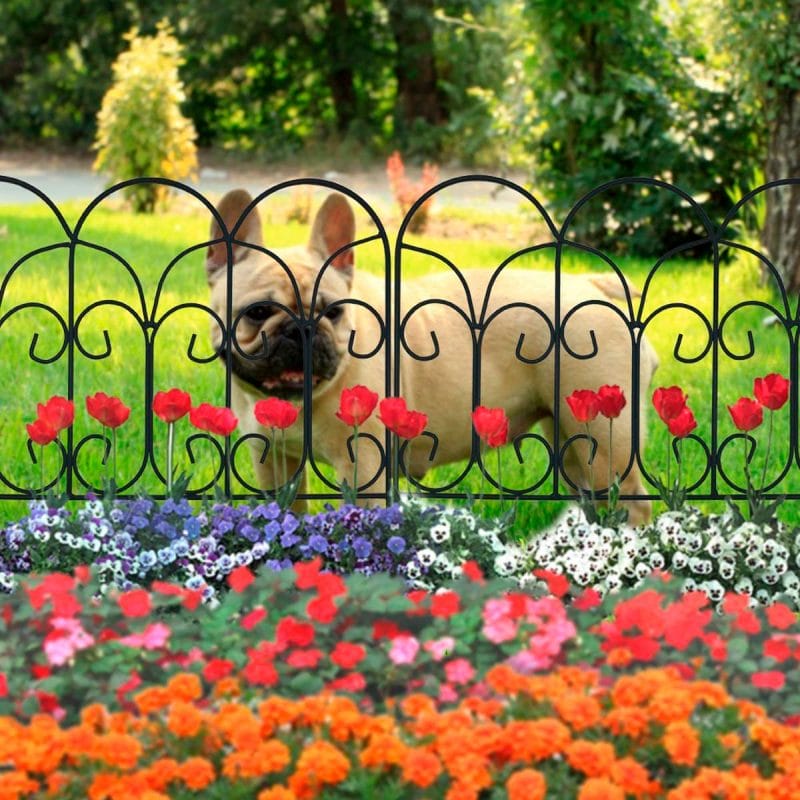
It is advisable to do landscaping in front of the metal fence boldly. It means to grow bold colored flower plants around the solid toned metal fence. Only by then the fence could highlight the flowerbeds and vice versa.
4. Trellis-Style Fence

This picture shows a back garden with walls built of half stone and half wood. In front of the barn door, which leads to a larger garden, there is a trellis-style fence surrounded by many kinds of plants, lavender is one of them.
5. Vinyl White Picket Fence

White picket is the dream fence for cottage garden. The picket fence building material varies from vinyl to wood. Some manufacturers even produce ones out of aluminum. It gets down to this: each material has its own thing to offer.
This vinyl one needs low maintenance. You do not need to regularly touchup and refinish, thus need not to be afraid of ruining the plants planted near the fence. Since it comes in white, any colored flowers will match in the landscaping plan, even for these white rimmed leaves.
6. Wooden White Picket Fence

This one is a white picket fence, too, but out of wood. While the previous vinyl one needs low maintenance, this wooden fence gives irresistible charm to your landscape, especially if there are blue and purple hydrangeas planted nearby as exemplified in the picture.
However, this wooden fence is not weatherproof. Choose some plants with good endurance in case you have to refinish the fence, though it is a good idea to do the planting in quite a distance from the fencing.
Types of Plants
It is not a difficult job to find the right plants for your fence since there are various types of shrubs, trees, and flowering vines. You will find the best ones to compliment your yards. Here are several suggestions.
7. Bamboo

If you want to grow something fast, it is better to consider bamboo. It grows tall super fast and appears to be commanding. Some species, among a thousand, even can grow up to 4 feet in only 24 hours.
Because of that, bamboo only fits to grow in residential areas where the gap between any two buildings is quite far. You would not want your bamboos’ growth disturbs the properties of your neighbors, would you Alternatively, you still could grow bamboo wherever, but under the permission of your next doors.
8. Chinese Jasmine Star Climber

In the picture, you see 18-month jasmines entirely cover a fence of 5 m long. It needs five jasmines in the planting process to be as wowing as this. For plants to grow this greatly only in 18 months, Chinese jasmine star is sure a fast grower. The key lies within good soil and regular watering.
9. Clematis Montana
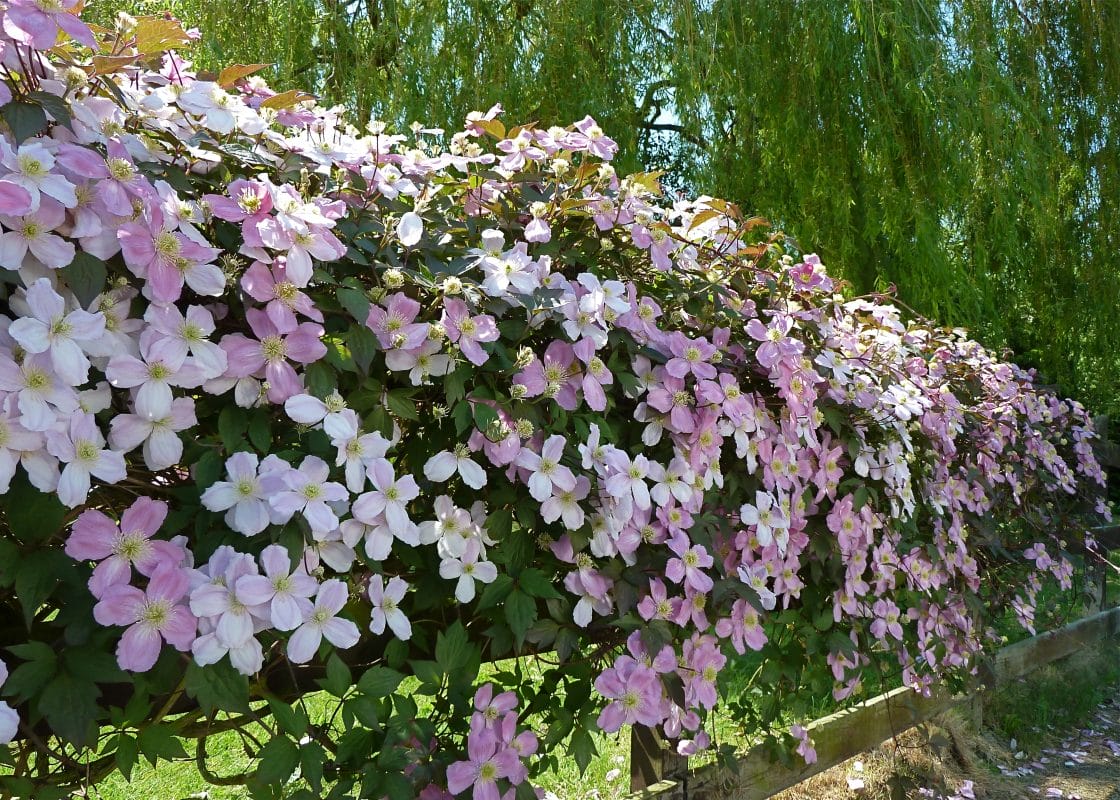
There are two types of clematis: vine varieties and short growing. The ones you see in the picture are the vine types. Clematis vines have good growth on trellises and fences due to its winding leaf stalks. It works wonder in covering a fence with 5” height.
READ: 22 Fall Landscape Ideas
If you want to grow the plant, pay good attention to these:
- Plan the planting starts from late winter to early spring when the clematis is dormant still.
- Place clematis away from kids’ reach, because it is poisonous if ingested and the sap might result in skin irritation.
- Wear gloves during working with soil.
10. Climbing Roses

Climbing roses come in various kinds. One of which is these freshening pink climbing roses on board fence. They bloom repeatedly throughout the year. Without pruning, these plants could reach up to 15–30 feet.
You plant them once; they will result in so many single blooms with conspicuous whites and yellows in the center.
11. Leyland Cypress Tree
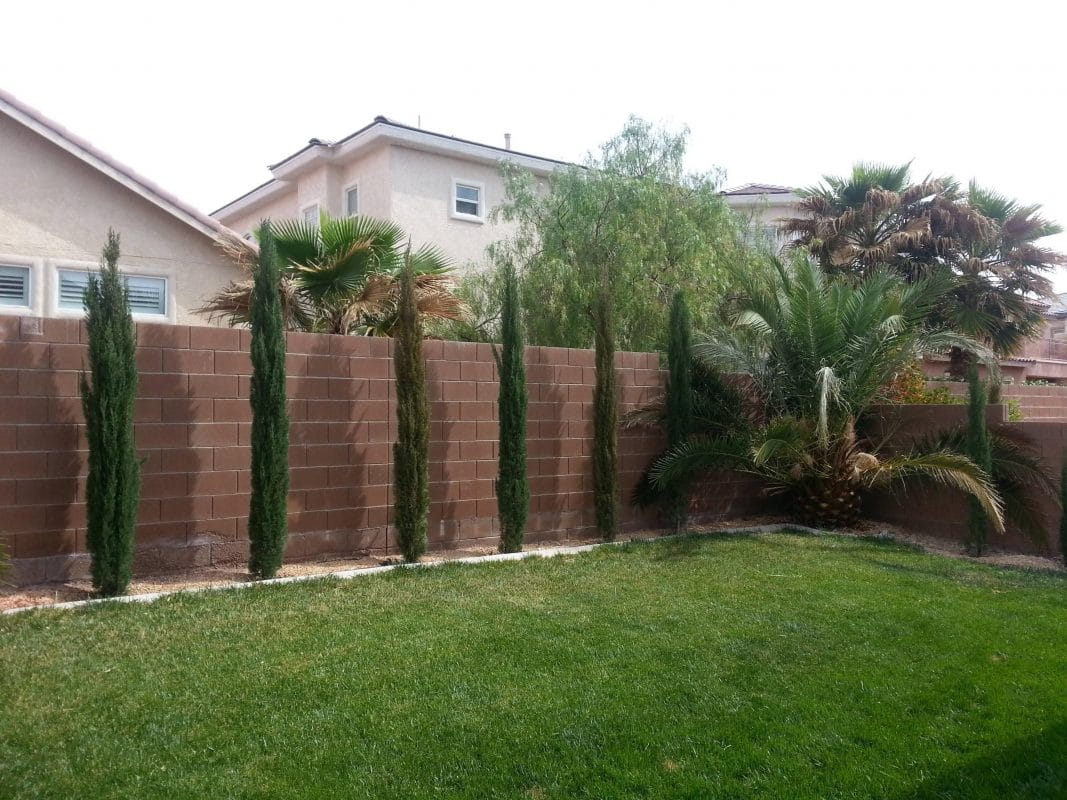
In giving privacy, Leyland cypress is one of the popular trees. The growth appearance of the cypress tree is narrow and tall, thus great for fully covered your yard. Have them planted in a row to establish a gorgeous line of impenetrable fence that will block strong wind and snow.
Leyland cypress trees grow wonderfully in well-drained areas with a range of mild to moderate temperatures.
Speaking of giving privacy, there are other tree alternatives aside from Leyland cypress, which is as good. Some of them are Spartan Juniper, Sky Pencil Holly, Green Giant Thuja, Emerald Green Thuja, Flowering Dogwood, Weeping Podocarpus, Goldspire Ginkgo, Eastern Redcedar, and Hybrid Willow.
12. Grapevines

Obtain beauty, function, and romantic vibes altogether by involving grapevines in your landscape design. The type of the fence in the picture might be not the best to grow grapevines among the group, but it shows that this climber could vegetate just fine in any media.
As long as it has natural light exposure and wind patterns sufficiently, grapevines will thrive greatly.
13. Honeysuckle Vines

Honeysuckles are long-blooming plants. They grow as clustered tubular flowers in cream shades, orange shades, purples, reds, and yellows. Prepare a sturdy fence if you want to grow these vines. As fast growers, honeysuckle vines will cover your fence shortly after planting.
They need regular maintenance of shaping and shearing because of that. Thin out the vine top half to keep it managed and healthy.
14. Italian Buckthorn

As seen in the image, Italian buckthorn has a growth habit of taller than it is widely. Therefore, this plant is perfect to plant in front of fences with minimal privacy to offer. Italian buckthorn needs low maintenance but occasional trimming whatsoever.
Growing Italian buckthorn is not a hard job since the plant is adaptive to almost any place, be it mountains, desert, or seacoast. This evergreen grows tall fast up to 10–20 feet high, especially when it gets regular watering.
15. Magnolia Trees
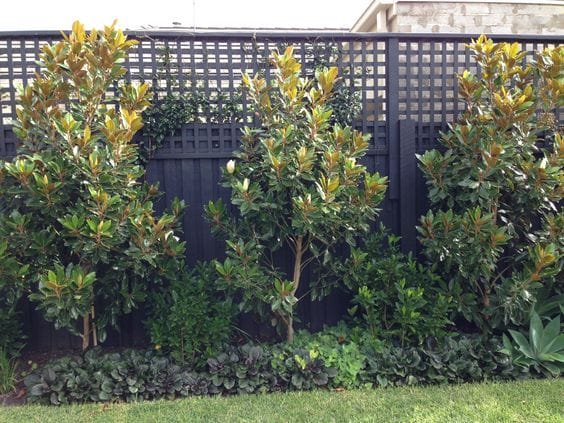
Magnolia is in the category of evergreen. If you want a complete coverage alongside the fence, growing magnolia trees is your safest bet as they have thick leaves. There are at least four different types of magnolias. Each type has its traits. You must choose one for your yard if not all.
They are as follows.
- Baby Grand. Baby Grand has a round form and small size, which affect majorly in small spaces.
- Fairy Magnolia. Fairy Magnolia is flawless for privacy, thanks to its evergreen foliage and compact growth.
- Felix Magnolia. Felix Magnolia is the best in giving a bold statement as it displays a daring fuchsia hue.
- Burgundy Star Magnolia. It is a strong plant with a delicate appearance that blooms earlier than the leaves.
Seasonal Planting
The best advice for planters in the four-seasonal country is to plan the planting throughout the year. Here is the tips list for the matter.
16. Bluebeard Shrubs for Summer

Though we call it shrubs, Bluebeard should be in the perennial category because it often dies back in cruel winter. Blooms in late summer, Bluebeard derives its name from the appearance. It has blue flowers with silvery-green leaves.
If you have this plant in summer, do not cut back once fall comes. You should do the pruning in early spring instead. Spring pruning will trigger new growth and flowers.
17. Evergreen Shrubs for Winter

This picture does not show the expected season, but evergreens grow magnificently during the time. With no flowers, evergreens explain virtually of how important foliages are. In white freezing winter, evergreens show all the colors plants should have.
The bests among the group to plant in colder climate are Mahonia japonica, Nandina domestica ‘firepower’, Nandina domestica ‘obsessed’, Viburnum davidii, Pinus mugo, Leucothoe, Hebe, Pseudowintera colorata, and Ilex aquifolium.
18. Perennials for Summer

Long blooming perennials are perfect for summer. The main reason why you should grow perennials in summer is to avoid the color gaps during the said season and winter. Besides, they also have resistance to dryness. You only need to plant them once, and they will regrow even after seasons.
You should choose from some perennials plants that grow in summer: coneflower, daylily, pincushion flower, and Asiatic lily.
19. Red Twig Dogwood for Winter

Red twig dogwood appears greatly during winter as seen in the picture. Its flaming red goes against the white snow incredibly. Thanks to this plant, we have a nice view other than the winter color. It might be because of the stone wall under, but this plant seems to have strong endurance.
20. Rose of Sharon for Summer

Rose of Sharon is a deciduous shrub, which blooms in late summer to fall. Popular by the name of shrub althea and Chinese hibiscus, these plants display a variety of colors in blue, lavender, pink, purple, red, and white. They could grow up to 8–12 feet tall and 6 –10 feet wide.
If you are an urban gardener, the rose of Sharon is appropriate to plan since it has good tolerance to pollution.
21. Shrubs for Fall Colors
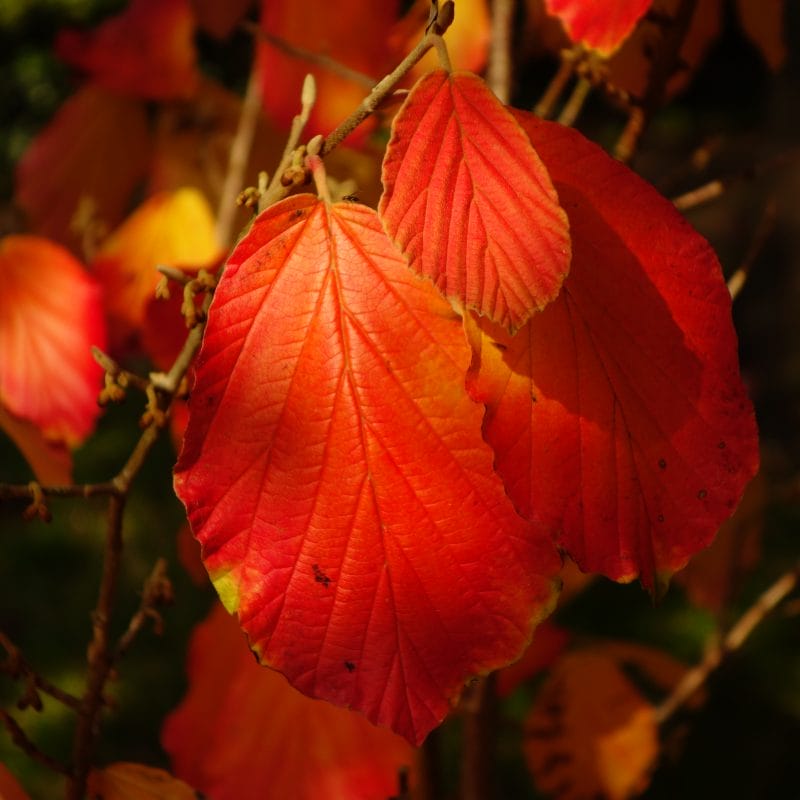
In this picture is Hamamelis x intermedia hybrids, a crossed plant between Chinese and Japanese witch hazel. More known as Arnold Promise, these shrubs are the spring early-bloomers. Besides red, Arnold Promise can also appear in fall colors of yellow and orange if shined sufficiently.
Apart from Arnold Promise, other shrubs have the perfect fall foliage shades as well. They are oakleaf hydrangea, sumac, dwarf fothergilla, spirea, Virginia sweetspire, viburnum, arrowwood viburnum, beautyberry, red chokeberry, and black chokeberry.
22. Tulips for Spring
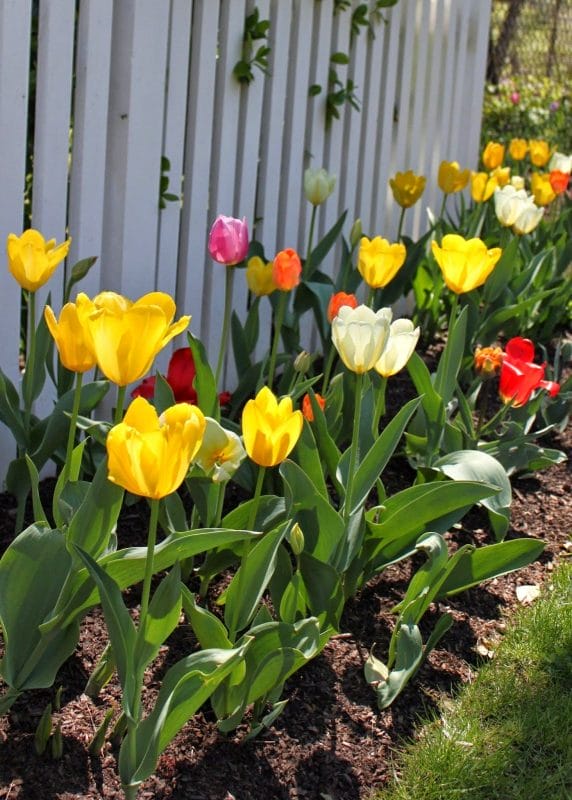
Tulips are the epitome of spring. However, the planting plan requires so much time before the blooming period. You must plant tulips that starts from fall until 14 weeks straight to enjoy their full bloom in the end. It is because tulips need to chill at the range temperature of 35–50 degrees Fahrenheit. So much effort to do to see this flower at its prettiest, yet the result is worth it.
You have reached the bottom of the page. As a closure, here are some bonus tips for you. Compose all the plants you have in mind within three rows: short plants in front, medium-sized ones in the middle, and tall plants in the back.
Next, use the fencing soft lines over the plant use for landscape edging. Lastly, promote privacy also by looser grouping the shrubs and trees.
Now, if you have finished viewing the landscaping along a fence ideas here, it is time for you to determine everything. Decide wisely based on what you have and need.